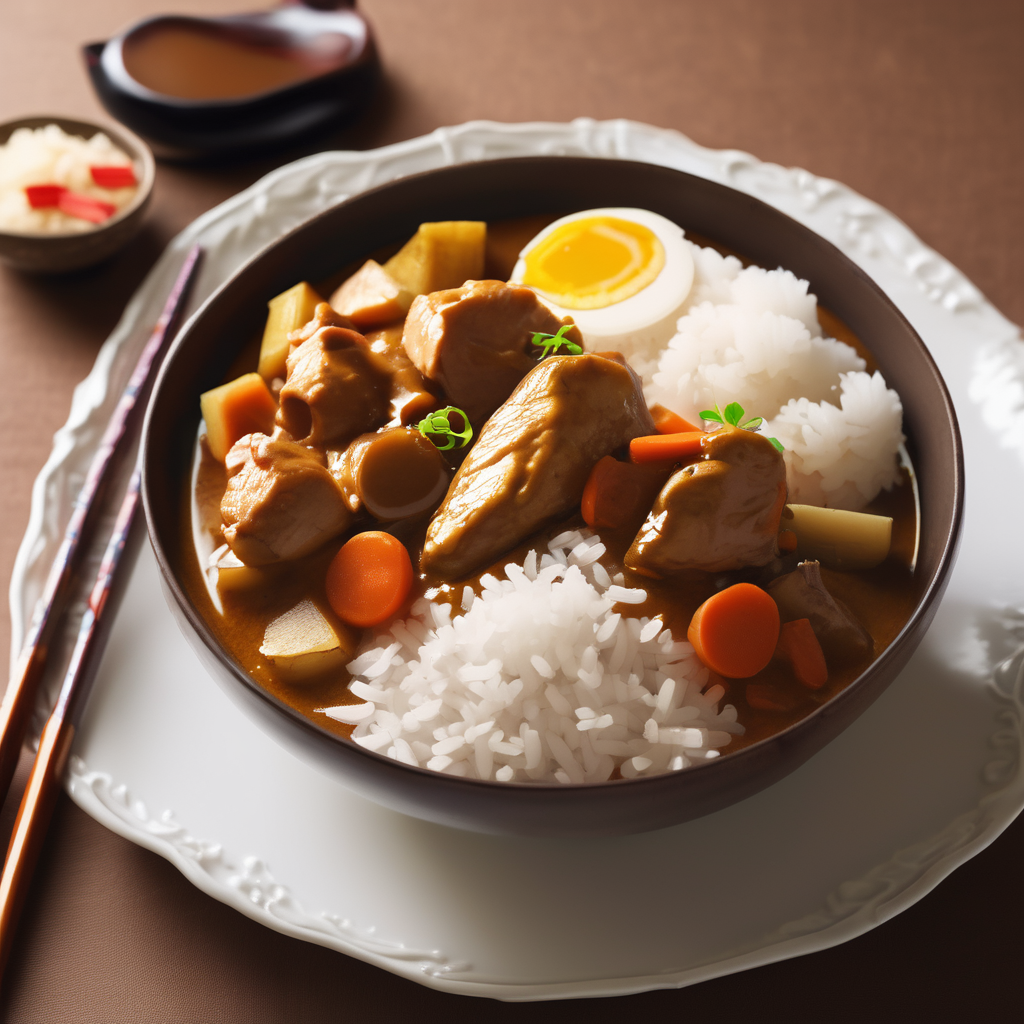Ingredients
Method
Step 1: Prepare the Ingredients
- Cut the chicken into uniform 1.5-inch pieces for even cooking
- Prepare vegetables using rangiri cutting - roll the carrot a quarter turn between each diagonal cut
- Slice onions into thick wedges to maintain texture during long cooking
- Cut potatoes into large chunks that won't fall apart during simmering
- Grate the apple finely to incorporate natural sweetness throughout the curry
Step 2: Create the Curry Roux
- Heat butter in a heavy-bottomed pot over medium-low heat. Add flour gradually while whisking constantly to prevent lumps. Cook the roux for 3-4 minutes until it turns light golden brown. Add curry powder and cook for another minute until fragrant. Stir in tomato paste and cook briefly to develop deep flavor. Set roux aside in a small bowl for later use.
Step 3: Build the Curry Base
- Heat oil in the same pot over medium-high heat. Season chicken with salt and sear until golden brown on all sides. Add onions to the pot and cook until softened and lightly caramelized. Add carrots and potatoes, stirring to coat with the aromatic base. Pour in the stock gradually, scraping up any browned bits from the bottom
Step 4: Simmer the Curry
- Add the grated apple and bay leaf to the pot. Bring to a boil, then reduce heat to low and simmer covered for 20 minutes. Check vegetable tenderness - potatoes should be fork-tender but not mushy. Remove bay leaf before proceeding to the next step
Step 5: Thicken and Season
- Gradually whisk in the prepared roux until completely dissolved. Add soy sauce and Worcestershire sauce for authentic Japanese flavor. Stir in honey to balance the spices with subtle sweetness. Simmer uncovered for 10 minutes until sauce thickens to coat the back of a spoon. Season with salt and white pepper to taste
Step 6: Serve the Kare-Raisu
- Prepare fresh Japanese rice using a rice cooker or stovetop method. Divide rice among serving bowls creating a neat mound on one side. Ladle curry over and around the rice allowing some rice to remain visible.
- Garnish with pickled vegetables (fukujinzuke) if available. Serve immediately while hot for the best experience.
Notes
Expert Tips for Perfect Japanese Curry
Choosing the Right Protein
For the curry, boneless chicken thighs are preferred because they tend to be fattier and yield more flavor compared to the breast, and they will shrink as they cook in the broth. However, beef chuck roast works equally well for a richer, more traditional flavor profile.Mastering the Roux Technique
Roux is a combination of flour and fat that is cooked and used as a base to thicken and flavor sauces. The method for making roux uses one part oil or fat to one part flour, whisked constantly over heat until it reaches an optimal shade of color. For Japanese curry, aim for a light golden color to avoid overpowering the delicate spice balance.The Rangiri Cutting Technique
This traditional Japanese cutting method involves rolling vegetables a quarter turn between each diagonal cut, creating irregular surfaces that better absorb flavors while maintaining structural integrity during long cooking times.Achieving the Perfect Consistency
The finished curry should have a gravy-like thickness that coats ingredients without being too thin or overly thick. If your curry becomes too thick, thin it with additional stock. If too thin, simmer uncovered longer to reduce.Cultural History and Significance of Kare-Raisu
The first chicken curry recipe appeared in Seiyo Ryori Tsu (The Western Cooking Expert), and earlier versions included ingredients like frog meat, leeks, shrimp, garlic, ginger, butter, salt, flour, and curry powder, and was boiled for one hour. This historical context shows how Japanese curry evolved from Western influences into something uniquely Japanese. Kare-Raisu represents more than just a meal - it's a symbol of Japan's ability to adopt and adapt foreign foods into something distinctly their own. Introduced during the Meiji era as part of Japan's modernization efforts, curry became so integrated into Japanese culture that most Japanese people consider it a native dish rather than an import.Nutritional Benefits of Japanese Curry Rice
Balanced Macronutrients
This hearty meal provides a well-balanced combination of carbohydrates from rice, protein from chicken, and healthy fats from the roux, creating a satisfying and energy-sustaining meal.Vegetable Content
The generous amount of carrots, onions, and potatoes provides essential vitamins, minerals, and dietary fiber, making this comfort food surprisingly nutritious.Antioxidant Properties
The curry spices, particularly turmeric found in curry powder, offer anti-inflammatory benefits and antioxidant properties.Digestive Benefits
The mild spice level makes this curry gentle on the digestive system while still providing the metabolic benefits associated with spiced foods.Serving Suggestions and Popular Variations
Classic Accompaniments
- Fukujinzuke - Traditional pickled vegetables that provide a tangy contrast
- Rakkyo - Pickled scallions for additional crunch and acidity
- Shredded cabbage salad - Fresh vegetables to balance the rich curry
Popular Variations
- Katsu Curry - Katsu curry is a variation of Japanese curry with a chicken cutlet on top. Adding chicken cutlet brings the Japanese curry up to the next level
- Seafood Curry - Substitute chicken with shrimp, scallops, or mixed seafood
- Vegetarian Curry - Replace meat with extra vegetables and mushrooms for umami
- Beef Curry - Traditional preparation using beef chuck for deeper flavor
Regional Specialties
Different regions of Japan have developed their own curry variations, from Hokkaido's seafood-rich versions to Okinawa's unique spice blends influenced by the islands' tropical location.Storage and Make-Ahead Tips
Japanese curry actually improves in flavor when made ahead, making it perfect for meal prep or entertaining. The flavors meld and deepen overnight, creating an even more satisfying dish.Proper Storage
- Refrigerate for up to 4 days in airtight containers
- Freeze portions for up to 3 months for convenient future meals
- Store rice separately to prevent it from becoming mushy
- Reheat gently on the stovetop with a splash of stock if needed
